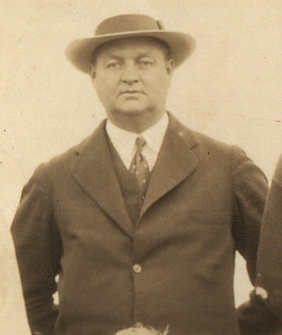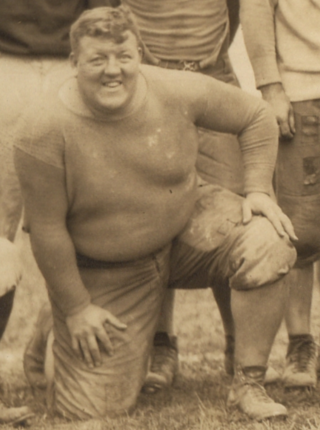Related Research Articles
The Akron Pros were a professional football team that played in Akron, Ohio from 1908 to 1926. The team originated in 1908 as a semi-pro team named the Akron Indians, but later became Akron Pros in 1920 as the team set out to become a charter member of the American Professional Football Association. Fritz Pollard, the first black head coach in the NFL, co-coached the Akron Pros in 1921. Paul Robeson played for the team in 1921 as well. He was among the earliest stars of professional football before football became segregated from 1934 to 1946. In 1926, the name was changed back to the Akron Indians, after the earlier semi-pro team. Due to financial problems, the team suspended operations in 1927 and surrendered its franchise the following year.
The Cleveland Bulldogs were a team that played in Cleveland, Ohio in the National Football League. They were originally called the Indians in 1923, not to be confused with the Cleveland Indians NFL franchise in 1922. However, after team owner Samuel Deutsch purchased the Canton Bulldogs in 1924, he merged the Canton team with his Indians and renamed his franchise the Cleveland Bulldogs. The Canton Bulldogs remained a part of the team until 1925, when they were sold back to Canton. The Cleveland Bulldogs played in the NFL until 1928 when they were relocated to Detroit and became the Detroit Wolverines. The team was later incorporated into the New York Giants in 1929. The Cleveland Bulldogs won the 1924 NFL championship.

The Frankford Yellow Jackets were a professional American football team, part of the National Football League from 1924 to 1931, although its origin dates back to as early as 1899 with the Frankford Athletic Association. The Yellow Jackets won the NFL championship in 1926. The team played its home games from 1923 in Frankford Stadium in Frankford, a section in the northeastern part of Philadelphia, noted for the Market–Frankford Line that terminates there.

The Providence Steam Rollers were a professional American football team based in Providence, Rhode Island in the National Football League (NFL) from 1925 to 1931. Providence was the first New England team to win an NFL championship. The Steam Roller won the league's championship in 1928, which is the latest NFL championship win by a defunct team to date. Most of their home games were played at the Cycledrome, a 10,000-seat stadium that was built as a velodrome for bicycle races.
Buffalo, New York had a turbulent, early-era National Football League team that operated under multiple names and several different owners between the 1910s and 1920s. The early NFL-era franchise was variously called the Buffalo All-Stars from 1915 to 1917, Buffalo Niagaras in 1918, the Buffalo Prospects in 1919, Buffalo All-Americans from 1920 to 1923, Buffalo Bisons from 1924 to 1925 and in 1927 and 1929, and the Buffalo Rangers in 1926. The franchise, which was experiencing financial problems in 1928, did not participate in league play that season.

The Orange Tornadoes and Newark Tornadoes were two manifestations of a long-lived professional American football franchise that existed in some form from 1887 to 1941 and from 1958 to 1970, having played in the American Amateur Football Union from 1888 to 1895, the National Football League from 1929 to 1930, the American Association from 1936 to 1941, the Atlantic Coast Football League from 1963 to 1964 and 1970, and the Continental Football League from 1965 to 1969. The team was based for most of its history in Orange, New Jersey, with many of its later years in Newark. Its last five seasons of existence were as the Orlando Panthers, when the team was based in Orlando, Florida. The NFL franchise was sold back to the league in October 1930. The team had four head coaches in its two years in the NFL – Jack Depler in Orange, and Jack Fish, Al McGall and Andy Salata in Newark.

The St. Louis Gunners were an independent professional football team based in St. Louis, Missouri, that played the last three games of the 1934 National Football League season, replacing the Cincinnati Reds on the league schedule after the Reds' league membership was suspended. They won their first game against the Pittsburgh Pirates 6–0, and lost the last two to the Detroit Lions (40–7) and the Green Bay Packers (21–14). Six of the Reds players joined the team for the last two games. The team was headquartered at the St. Louis National Guard Armory, which accounts for its nickname the 'Gunners'.
Louisville, Kentucky had two professional American football teams in the National Football League: the Louisville Breckenridges from 1921 to 1924 and the Louisville Colonels in 1926.
The Staten Island Stapletons, also known as the Staten Island Stapes, were a professional American football team. Founded in 1915, they played in the National Football League (NFL) from 1929 to 1932. The team was based in the Stapleton section of Staten Island. They played under the shortened nickname the "Stapes" the final two seasons.
Below is a list of professional football Championship Games in the United States, involving:

Elmer Francis Layden was an American football player, coach, college athletics administrator, and professional sports executive. He played college football for the Notre Dame Fighting Irish where he starred at fullback as a member of the legendary "Four Horsemen" backfield. Layden played professionally in the original AFL in 1925 and 1926 with three clubs, the Hartford Blues, the Brooklyn Horsemen, and the Rock Island Independents. He began his coaching career during the same two seasons at Columbia College in Dubuque, Iowa, now known as Loras College. Layden then served as the head coach at Duquesne University from 1927 to 1933 and at his alma mater, Notre Dame, from 1934 to 1940, where he also held the position of athletic director. From 1941 to 1946, Layden was the commissioner of the National Football League (NFL). He was inducted into the College Football Hall of Fame as a player in 1951.
The 1926 NFL season was the seventh regular season of the National Football League. The league grew to 22 teams, a figure that would not be equaled in professional football until 1961, adding the Brooklyn Lions, the Hartford Blues, the Los Angeles Buccaneers, and the Louisville Colonels, with the Racine Tornadoes re-entering. The Cleveland Bulldogs sat out the season, the Rock Island Independents defected to the upstart American Football League, and the Rochester Jeffersons suspended operations for the final time. The Akron Pros re-branded as the Akron Indians, the Duluth Kelleys as the Duluth Eskimos and the Buffalo Bison as the Buffalo Rangers. .
The 1927 NFL season was the eighth regular season of the National Football League. Prior to the season, the league decided to eliminate the financially weaker teams. As a result, the league dropped from 22 to 12 teams. The league absorbed many players and one franchise from the defunct American Football League. Wilfrid Smith in the Chicago Tribune wrote that "the reduction formed a more compact circuit and provided better competition." Smith opined that the "outstanding feature" of the 1927 NFL season was the debut of Benny Friedman who became one of the game's "best drawing cards" and proved that professional football could support itself in Cleveland.
The American Association (AA) was a professional American football minor league based in New York City. Founded in 1936 with teams in New York and New Jersey, the AA extended its reach to Providence, Rhode Island prior to the onset of World War II. After a four-year hiatus, the league was renamed the American Football League as it expanded to include teams in Ohio and Pennsylvania. In 1947, the Richmond Rebels of the Dixie League purchased the assets of the defunct AFL Long Island Indians and jumped leagues.
The Ohio League was an informal and loose association of American football clubs active between 1902 and 1919 that competed for the Ohio Independent Championship (OIC). As the name implied, its teams were mostly based in Ohio. It is the direct predecessor to the modern National Football League (NFL).

George F. Mulligan (1880–1955) was the leading sports promoter in Connecticut during the early 1900s. He was also the founder and owner of the Hartford Blues of the National Football League. The Blues, which were referred to as the Waterbury Blues, began as a semi-pro football team in 1924, before joining the early NFL in 1926.
The 1927 Hartford Giants season was their fourth and final season in existence. The team played the prior season as the Hartford Blues of the National Football League. However, after the 1926 season, the NFL's owners voted to cut down the number of teams from 22 to 12. As a result, Hartford's franchise was eliminated. Blues' owner George Mulligan reorganized the team into a semi-pro team, the Hartford Giants. The data for the team's overall record is incomplete, however it is clear that posted a 7–1 record in the game results that are known. The Giants would disband for good after the season.
The Canton Bulldogs were a professional American football team, based in Canton, Ohio. They played in the Ohio League from 1903 to 1906 and 1911 to 1919, and the American Professional Football Association, from 1920 to 1923, and again from 1925 to 1926. The Bulldogs won the 1916, 1917, and 1919 Ohio League championships. They were the NFL champions in 1922 and 1923. In 1921–1923, the Bulldogs played 25 straight games without a defeat. This remains an NFL record.
John A. Bonadies, sometimes called Giovanni A. Bonadies was an Italian professional American football guard and tackle who played one season in the National Football League (NFL) for the Hartford Blues. Born in Corleto Perticara, his family moved to United States when he was young. At the age of 34 in 1926, Bonadies was called to play professional football with the Blues. He appeared in five games, all as a backup.

Edward Felix Keenan was an American football guard who played one season in the National Football League (NFL) for the Hartford Blues. He played college football at Washington College. Weighing 320 pounds, Keenan was the largest person in the game at the time. He also spent time with the New York Yankees and New York Giants.
References
- Hogrogian, John (1982). "The Hartford Blues Part II" (PDF). Coffin Corner. 4 (9). Professional Football Researchers Association: 1–5. Archived from the original (PDF) on 2010-11-27. Retrieved 2010-09-09.
- Complete Football Records